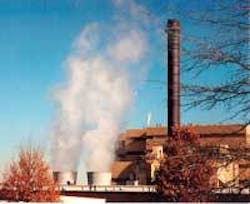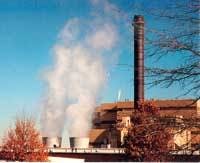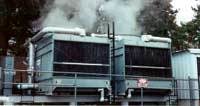Legionella Risks in Cooling Towers Require Proactive Vigilance
by Bob Whitcomb
Ever notice that mist plume emanating from your cooling tower? Do you ever wonder whether it contains harmful elements or could be a risk to anyone nearby? Depending on the location and condition of the cooling tower, there are some risks inherent in that billowing mist.
The emphasis here is on preventing that risk from endangering the public, especially as it pertains to anyone contracting Legionnaires’ Disease, the pneumonia-type illness that led to 34 deaths at an American Legion convention in Philadelphia in 1976. It was determined to be caused by the bacteria now known as Legionella pneumophila, often found growing in cooling towers. The disease is now commonly reported by disease control centers and in the press, and is one of the top three causes of community-acquired pneumonia. There are estimates of 25,000 or more U.S. cases each year, with over 4,000 deaths attributed annually to it. L. pneumophila is such a health risk that OSHA has devoted an entire chapter in its Technical Manual to the subject of recognizing, investigating and controlling the disease.
So how does this relate to assessing any risk from the mist billowing from your cooling tower? It means you may need to look at the mist from a different perspective. Not only should you be concerned about energy efficiency and cleanliness of the water in the cooling tower, but also about where that mist travels - and whether it presents a high or low risk to “your public.” In this case, that public has to be considered anyone in the vicinity or downwind of the mist. Is there an air intake for the building or a restaurant that could draw water vapors from that mist? Is there a school, hospital or facility for the elderly nearby? The public that’s at greater risk of contracting Legionnaires’ Disease are those with weaker immune systems, such as the elderly, anyone with lung disease (e.g., asthmatics), children or smokers.
Most often, you won’t have the option of moving that cooling tower or redirecting the mist. Yet understanding these factors will change how you react if a problem occurs. It should also affect how often tests are conducted for Legionella in the cooling tower. For example, if it’s near ground level, or if there’s a nursing home next door that might have its fresh air intake or its own cooling tower downwind of yours, then testing should be more often, perhaps every month.
How do you monitor and control Legionella? The first step is to have a professional water treatment program for the cooling tower that includes alternating micro-biocides to control biological growth. Also helpful is ensuring complete water circulation, keeping the sump clean of accumulating dirt, and removing any biofilms that should develop. The water should be tested regularly for L. pneumophila bacteria using a certified laboratory. If your water treatment company doesn’t offer this service, then you can obtain your own samples and send them to a professional lab.
The question of what type of testing program is necessary has long been debated among industry experts. The Association of Water Technologies, which represents regional water treatment companies nationwide, has examined the issue in depth. It has issued position papers on Legionella in 2000 and 2003, with the latest edition strengthening a recommendation to building managers to assess their facilities for need of a program. In essence, they suggest that facilities with a higher-risk “public” should be the ones taking a more pro-active approach to the bacteria’s detection and prevention.
Testing for L. pneumophila should be performed on cooling tower waters and domestic hot water heaters quarterly at the very minimum.
A pro-active water treatment and Legionella testing program should be an integral part of every building’s preventive management program. This is as important as annual elevator inspections, which facility managers always include in their operating budgets. With such a program, and with the health care industry being more aware and diligent towards detecting and treating any outbreaks of Legionnaires’ Disease, this country should no longer have to read about tragic deaths caused by Legionella bacteria.
About the Author: Bob Whitcomb is vice president for ARC Testing Services, of Jessup, MD, which has over 40 years of experience in the industry including involvement in the original Legionnaire’s Disease outbreak in 1976. Contact: 866-360-0557 or [email protected]


